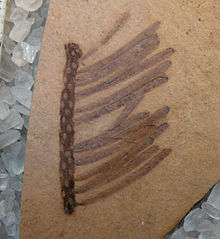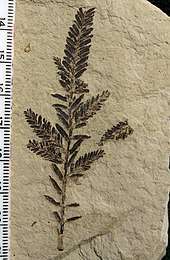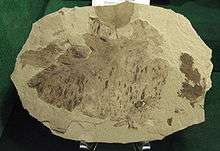Allenby Formation
The Allenby formation is a sedimentary rock formation deposited during the early to early Middle Eocene. It consists of conglomerates, sandstones with interbedded with shales and coal. The coal seams contain an abundance of insect, fish and plant fossils, known from the shales since 1877[2][3][4] but best known from the Princeton Chert.[1]
| Allenby Formation Stratigraphic range: 52.5–48 Ma | |
|---|---|
| Type | Geological formation |
| Sub-units | Princeton Chert |
| Area | 300 km².[1] |
| Thickness | 1860-2100 m.[1] |
| Lithology | |
| Primary | Fluvial deposits |
| Other | shale–sandstone, coal–breccia, and coal–chert |
| Location | |
| Coordinates | 49°22.6′N 120°32.8′W |
| Region | British Columbia |
| Country | Canada |
| Type section | |
| Named for | Allenby, British Columbia (Shaw, 1952) |
Flora and fauna
The following fossil genera and species have been described from the Allenby formation:
Conifers, ferns, and ginkgos
| Name | Authority | Year | Family | Notes | Images |
|---|---|---|---|---|---|
|
Shorn & Wehr, 1986 |
2013 |
Oldest true fir described |
| ||
|
Arnold, 1955 |
1955 |
A mosquito fern |
| ||
|
2002 |
A ginkgo |
| |||
|
Mustoe, 2002 |
2002 |
A ginkgo |
| ||
|
1987 |
A dawn redwood |
| |||
Flowering plants
| Name | Authority | Year | Family | Notes | Images |
|---|---|---|---|---|---|
|
Wolfe & Tanai |
1987 |
A maple |
|||
|
Wolfe & Tanai |
1987 |
A maple |
|||
|
Wolfe & Tanai |
1987 |
A maple |
|||
|
Wolfe & Tanai |
1987 |
A maple |
|||
|
Alnus parvifolia[3] |
(Berry) Wolfe & Wehr |
2013 |
An Alder |
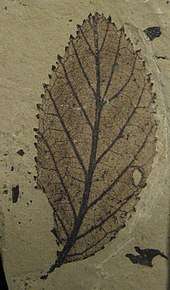 Alnus parvifolia | |
|
Wolfe & Wehr |
1987 |
A birch |
| ||
|
Fagopsis undulata[9] |
(Knowlton) Wolfe & Wehr |
2013 |
A beech |
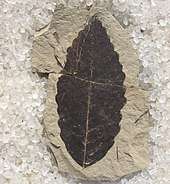 Fagopsis undulata | |
|
Fothergilla dunthornei[10] |
Radtke, Pigg, & Wehr |
2005 |
Hamamelidaceae |
A witch alder |
|
|
DeVore, Moore, Pigg, & Wehr |
2004 |
A snow wreath |
|||
|
Bogner, Johnson, Kvaček & Upchurch |
2007 |
| |||
|
Pistillipollianthus wilsoni[13] |
Stockey & Manchester |
1988 |
incertae sedis |
A flower of unidentified affinity |
|
|
Palaeocarpinus stonebergae[14] |
Pigg, Manchester, & Wehr |
2003 |
Betulaceae |
A betulaceous genus |
|
|
Berry |
2013 |
Lauraceae |
A laural genus |
| |
|
Wolfe & Wehr |
1988 |
A Sorbarieae genus |
|||
|
Tetracentron hopkinsii[16] |
Pigg et al |
2007 |
A Tetracentron relative |
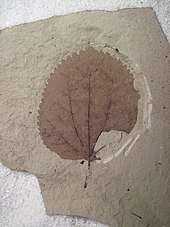 Tetracentron hopkinsii | |
|
Wolfe & Wehr |
2013 |
A dove-tree relative |
| ||
|
Denk & Dillhoff |
2007 |
An Elm |
| ||
Insects and mammals
| Name | Authority | Year | Family | Notes | Images |
|---|---|---|---|---|---|
|
Dinokanaga wilsoni[18] |
Archibald, 2005 |
2005 |
A scorpion fly species |
||
|
Rice, 1968 |
1968 |
A Sawfly |
|||
|
Rice, 1968 |
1968 |
A Sawfly |
|||
|
Eberle, 2017 |
1935 |
Esthonychidae |
A Tillodontia genus |
||
References
- Mustoe, G.E. (1 January 2011). "Cyclic sedimentation in the Eocene Allenby Formation of south-central British Columbia and the origin of the Princeton Chert fossil beds". Canadian Journal of Earth Sciences. 48 (1): 25–43. doi:10.1139/E10-085.
- Penhallow, D.P. 1908. A report on Tertiary plants of British Columbia, collected by Lawrence M. Lambe in 1906 together with a discussion of previously recorded Tertiary floras. Canada Department of Mines, Geological Survey Branch, No. 1013. pp. 1–167.
- Dillhoff, R.M.; Dillhoff, T.A.; Greenwood, D.R.; DeVore, M.L.; Pigg, K.B. (2013). "The Eocene Thomas Ranch flora, Allenby Formation, Princeton, British Columbia, Canada". Botany. 91 (8): 514–529. doi:10.1139/cjb-2012-0313.
- Greenwood, D.R.; Pigg, K.B.; Basinger, J.F.; DeVore, M.L. (2016). "A review of paleobotanical studies of the Early Eocene Okanagan (Okanogan) Highlands floras of British Columbia, Canada, and Washington, U.S.A.". Canadian Journal of Earth Sciences. 53 (6): 548–564. doi:10.1139/cjes-2015-0177.
- Arnold, C. A. (1955). "A Tertiary Azolla from British Columbia" (PDF). Contributions from the Museum of Paleontology, University of Michigan. 12 (4): 37–45.
- Mustoe, G.E. (2002). "Eocene Ginkgo leaf fossils from the Pacific Northwest". Canadian Journal of Botany. 80 (10): 1078–1087. doi:10.1139/b02-097.
- Chaney, R.W. (1951). "A revision of fossil Sequoia and Taxodium in western North America based on the recent discovery of Metasequoia". Transactions of the American Philosophical Society. 40 (3): 231.
- Wolfe, J.A.; Tanai, T. (1987). "Systematics, Phylogeny, and Distribution of Acer (maples) in the Cenozoic of Western North America". Journal of the Faculty of Science, Hokkaido University. Series 4, Geology and Mineralogy. 22 (1): 23, 74, 75, 240, & plate 4.
- Wolfe, J.A.; Wehr, W.C. (1987). "Middle Eocene dicotyledonous plants from Republic, northeastern Washington". United States Geological Survey Bulletin. 1597: 1–25.
- Radtke, M.G.; Pigg, K.B.; Wehr, W.C. (2005). "Fossil Corylopsis and Fothergilla Leaves (Hamamelidaceae) from the Lower Eocene Flora of Republic, Washington, U.S.A., and Their Evolutionary and Biogeographic Significance". International Journal of Plant Sciences. 166 (2): 347–356. doi:10.1086/427483.
- DeVore, M.L.; Moore, S.M.; Pigg, K.B.; Wehr, W.C. (2004). "Fossil Neviusia leaves (Rosaceae: Kerrieae) from the Lower Middle Eocene of Southern British Columbia". Rhodora. 12 (927): 197–209. JSTOR 23314752.
- Bogner, J.; Johnson, K. R.; Kvacek, Z.; Upchurch, G. R. (2007). "New fossil leaves of Araceae from the Late Cretaceous and Paleogene of western North America" (PDF). Zitteliana. A (47): 133–147. ISSN 1612-412X.
- Stockey, R. A.; Manchester, S. R. (1988). "A fossil flower with in situ Pistillipollenites from the Eocene of British Columbia". Canadian Journal of Botany. 66 (2): 313–318. doi:10.1139/b88-051.
- Pigg, K.B.; Manchester S.R.; Wehr W.C. (2003). "Corylus, Carpinus, and Palaeocarpinus (Betulaceae) from the Middle Eocene Klondike Mountain and Allenby Formations of Northwestern North America". International Journal of Plant Sciences. 164 (5): 807–822. doi:10.1086/376816.
- Wolfe, J.A.; Wehr, W.C. (1988). "Rosaceous Chamaebatiaria-like foliage from the Paleogene of western North America". Aliso. 12 (1): 177–200. doi:10.5642/aliso.19881201.14.
- Manchester, S.; Pigg, K. B.; Kvaček, Z; DeVore, M. L.; Dillhoff, R. M. (2018). "Newly recognized diversity in Trochodendraceae from the Eocene of western North America". International Journal of Plant Sciences. 179 (8): 663–676. doi:10.1086/699282.
- Denk, T.; Dillhoff, R.M. (2005). "Ulmus leaves and fruits from the Early-Middle Eocene of northwestern North America: systematics and implications for character evolution within Ulmaceae". Canadian Journal of Botany. 83 (12): 1663–1681. doi:10.1139/b05-122.
- Archibald, S.B. (2005). "New Dinopanorpidae (Insecta: Mecoptera) from the Eocene Okanagan Highlands (British Columbia, Canada and Washington State, USA)". Canadian Journal of Earth Sciences. 42 (2): 119–136. doi:10.1139/e04-073.
- Rice, H.M.A. (1968). "Two Tertiary sawflies, (Hymenoptera - Tenthredinidae), from British Columbia". Geological Survey of Canada. 67 (59): 1–21.
- Russell, L.S. 1935. A middle Eocene mammal from British Columbia. American Journal of Science, 29: 54–55.
- Eberle, J.J., & Greenwood, D.R. (2017). An Eocene brontothere and tillodonts (Mammalia) from British Columbia, and their paleoenvironments. Canadian Journal of Earth Sciences, 54(9): 981-992.
